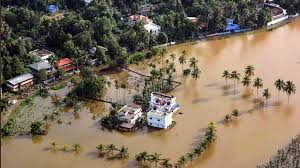Essay Composition On – National Flood Control Policy – For W.B.C.S. Examination.
The subject of floods control is not particularly mentioned in any of the three legislative lists of the Constitution. However, Drainage and Embankments are mentioned in State list. Thus the primary responsibility to deal with floods is of states. The role of central government is technical and advisory in nature. The states have to prepare plans for flood control based on the local needs.Continue Reading Essay Composition On – National Flood Control Policy – For W.B.C.S. Examination.
Presently India has two tier flood management systems viz. state level mechanism and central government mechanism. The State Level Mechanism includes the Water Resources Departments, Flood Control Board and State Technical Advisory Committee. The Central Government Mechanism includes several organizations and various expert committees to enable the State Governments in addressing flood problems in a comprehensive manner.
The National Flood Control Policy comprises three phases:
(i) Immediate phase extends over two years and comprises collection of basic hydrological data, construction of embankments, urgent repairs, improvement of river channels and raising of villages above flood levels.
(ii) Short-term phase concerns the next four to five years. It consists of improving surface drainage, establishing proper flood warning system, shifting or raising of villages over flood level, construction of channel diversions, more embankments and construction of raised platforms for use in times of flood emergency.
(iii) Long-term phase envisages schemes such as construction of dams or storage reservoirs for flood protection and soil conservation in the catchment of various rivers, detention basins, and digging large channel diversions.
Under the National Flood Control Programme, launched in 1954, protection measures have been taken up since second plan. Emphasis has been given to drainage and anti-water logging measures. Flood forecasting and warning centres have been established in some of the most flood prone areas. Flood Control Boards and River Commissions have been set up in all states to coordinate and implement the measures.
A Central Flood Control Board, at the national level, has been set up to coordinate the work of State Boards and River Commissions. Multipurpose reservoirs with specific storage for flood control have been constructed on the Mahanadi (at Hirakud), the Damodar (at Konar, Maithon, Panchet and Tilaiya); on the Satluj (at Bhakra), on the Beas (at Pong); and on the Tapti (at Ukai), which have afforded considerable protection to the lower areas of the rivers.
A number of multipurpose reservoirs, like the Bhakra Nangal on Satluj, the Nagarjun Sagar etc., though not having any specific storage for flood moderation, have given incidental benefits of flood moderation in downstream areas. In addition, a number of flood protection works including construction of embankments, drainage channels, town protection works and raising of villages have been carried out. Flood forecasting systems have also been set up at various places.
Please subscribe here to get all future updates on this post/page/category/website


 +919674493673
+919674493673  mailus@wbcsmadeeasy.in
mailus@wbcsmadeeasy.in







































































































